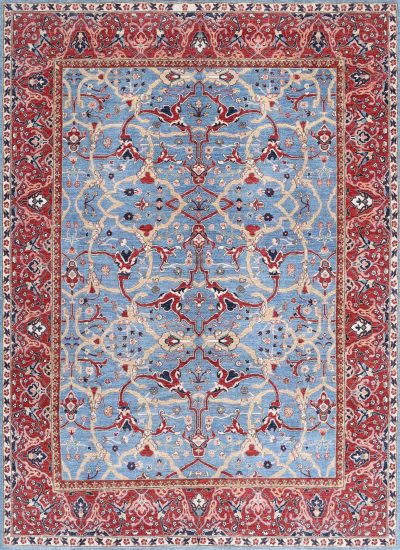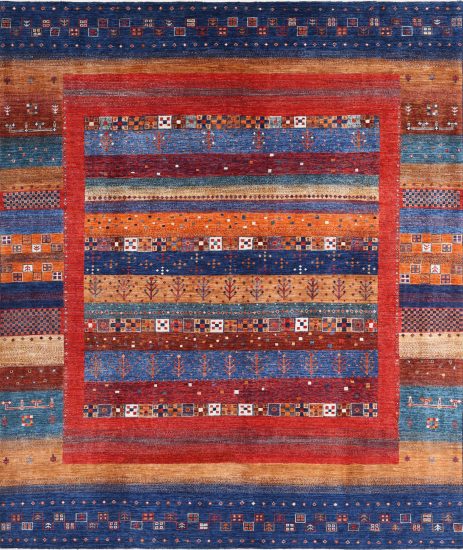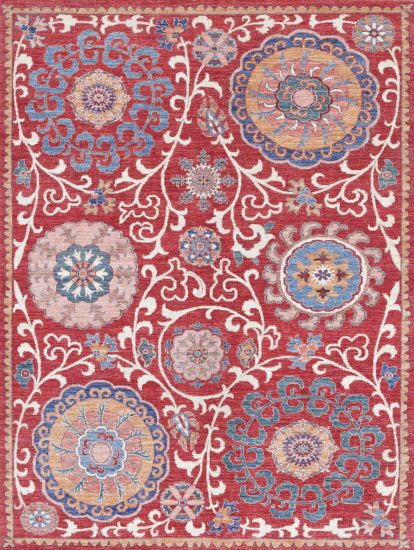Oushak
Fine Oushak Rugs
Oushak rugs have been a renowned and highly sought-after category of Oriental rugs since the 15th century.
Preserving the art of Oushak rug-making is crucial to maintaining these beautiful rugs’ cultural heritage and craftsmanship.
Origin and History
Oushak rugs are traditional Turkish rugs named after the city where they originated from. These rugs originated in Oushak, a larger city in Western Anatolia in Turkey.
Western Anatolia was a major rug-producing region from the early days of the Ottoman Empire until the early 20th century.
Its strategic location along trade routes helped to spread its reputation as a center for high-quality rug production.
Oushak is still produced in this region. They are also known as Usak rugs. Although Oushak rugs originated in Turkey, today, Pakistan has become the main producer of these gorgeous hand-knotted rugs.
Table of Contents
How Do You Pronounce Oushak?
Oushak” rugs are pronounced as “oo-shak,” with the “oo” sound like in “moon” and “shak” rhyming with “back”.
What Makes a True Oushak Rug?
A true Oushak rug has distinctive features that set them apart from other hand-woven rugs and make them easy to identify.
Oushak rugs are known for their subtle designs and large, spaced-apart motifs. The balanced use of open space and warm, muted color palettes, including terracotta, gold, and soft blues, contribute to their distinct appearance.
Traditionally made from high-quality wool, Oushak rugs are hand-knotted using the Turkish or Ghiordes knot, resulting in a durable, long-lasting product. With a lower pile height, these rugs have a soft, antique look.
Antique Oushak rugs are sought for their beautiful, unique designs, craftsmanship, and historical significance.
How Oushak Rugs Are Woven
Oushak rug weavers are highly skilled. They start learning traditional, artistic knotting techniques from the earlier generations from a very young age. Over the years, they have mastered these techniques and used them to produce unique rugs.
Materials
Wool: Oushak rugs are typically made from high-quality wool, which gives them a soft, plush feel and ensures their durability.
Cotton: Oushak rugs incorporate cotton in their foundation or weft, providing additional strength and stability.
Silk: Though less common, silk Oushak rugs are prized for their luxurious sheen and fine craftsmanship.
Foundation and Pile
The pile of Oushak rugs is always made of wool, while the foundation is almost always cotton. The cotton foundation gives the rugs stability while making them more durable. The wool pile gives the rugs their famed soft, lush, luxurious look and feel.
The weavers sourced, treated and dyed the wool for the pile and the cotton for the foundation. This gives them total control over how their finished rugs look and feel.
The weavers source the wool from their herd of sheep. They then wash the wool and hand spin it into fine yarn. This yarn is then dyed using purely natural dyes made from parts of assorted plants and vegetables available in the surrounding areas. When the dyed yarn is dried, it creates the magnificent Oushak rugs we see today.
Knotting Techniques
Oushak rugs are hand-knotted using the Turkish or Ghiordes knot, known for their strength and resilience. This knotting technique contributes to the durability and long-lasting nature of these rugs.
Design
Oushak rugs feature a variety of motifs, including geometric, floral, and medallion designs. These motifs often blend traditional and contemporary elements, making Oushak rugs suitable for various interior design styles.
Their hallmark star and medallion pattern easily recognizes Oushak rugs. However, please note that this does not mean that all Oushaks have the same design. Innovative workshops use their creativity to design unique star and medallion pattern variations. This has resulted in beautiful Oushak rugs featuring endless variations of the basic pattern, each unique.
Around the end of the late 19th century, the designs underwent a couple of shifts in keeping with changing trends in Persian and Europe. The first change was the introduction of floral patterns in Persian rugs. As Persian design trends heavily influenced Oushak rugs, weavers began incorporating floral patterns into Oushak rug designs.
The second change resulted from creating of room-size rugs, which Europeans preferred over smaller ones. Interestingly, weavers changed the designs to suit modern trends while retaining traditional aesthetics.

Colors of Oushak Rugs

Oushak rugs are known for their warm and muted color palette, often including shades of red, blue, green, gold, and ivory. Older Oushak rugs mainly consisted of deep, dark colors such as deep reds, blues, browns, and terracotta with little flecks of white or yellow.
Weavers tended to use just three or four main colors that dominated the rug’s design. Red was typically the field color.
With the production of commercial rugs that catered to Western tastes, the colors began to get a little muted. Washed and muted earth tones and colors dominate the field, including abundant terracotta tints, cinnamon, saffron, gold, ivory, and apricot, often combined with light blues, greys, and greens.
One feature of Oushak rugs that has remained unchanged through the centuries is that the dyes are created from all-natural materials. Synthetic materials and chemicals are never used.
The weavers extracted the dye from materials such as stems, leaves, roots, and flowers of plants and trees nearby.
Oushak Rug Borders
Most Oushak rugs have intricate borders that frame the central design and add a layer of visual interest.
Sizes Available
4 Types of Oushak Rugs
Oushak rugs can be classified into type, predominant pattern, and color. The four groups are Medallion Oushak, Starry Oushak, Bird Oushak, and Holbein and Lotto Oushak.
Medallion Oushak
The field of a Medallion Oushak rug typically features a central medallion surrounded by geometric motifs and framed by quarter medallions in the four corners. The insides and the open area between the motifs are filled with small ornamental patterns. These could be in miniature stylized medallions, sprays of palmettes or vine scrolls, or compositions featuring animal and human figures.
In these rugs, the central medallion symbolizes infinity. The arrangement of the motifs and the colors always recreate an elegant and sophisticated effect while exuding warmth and comfort – an unbeatable combination. In some variations, these rugs have angular large-scale floral patterns.
The Corner Medallion is a variation of the Medallion rug design. In this type of rug, flowers and various floral elements adorn the main Tree of Life design. The spike of the flowers represents the dragon, which symbolizes fertility.
Starry Oushak
Starry Oushak Rugs predominantly feature octagonal star motifs that symbolize deeper meanings, such as birth, the renewal of the universe, and life in peace. A distinctive feature of Starry Oushak rugs is that these rugs do have a medallion indicating the center of the rug.
Instead, the stars are connected in an endless pattern, emphasizing the motifs’ meanings and the theme of the rugs – birth and renewal.
Starry Oushak rugs are generally medium-sized. They typically featured red medallions on a field of blue or blue medallions on a field of red.
Bird Oushak
Bird Oushak rugs almost always feature a field of very light colors, usually white or a very light cream shade. This light-colored field is adorned with various patterns, including birds, leaves, and sprays of palmettes.
The main motif comprises leaves in various colors, mainly dark blue, red, and orange-yellow. However, the way the leaves are arranged on the ground gives the appearance of two leaves meeting each other. At first glance, this looks like a bird.
Holbein and Lotto Type
Holbein and Lotto rugs are named after two famous painters fascinated by the rugs and often featured them in their paintings.
Holbein rugs are often featured in the paintings of the renowned German painter of the period, Hanz Holbein. Hanz Holbein was fascinated by the designs in which the dragon motifs were designed as clouds formed the border of the rugs. The central area of these rugs features a variety of motifs. The overall design symbolized the dragons of the border protecting life and fertility, which was depicted by the central motifs.
Lotto rugs feature an arabesque all-over design with assorted Tree of Life, dragon, and bird motifs and ornate patterns. The motifs and designs represented immortality and eternity of the soul. The arabesque design is typically created on a red background.
These rugs were a particular favorite of 16th-century Italian artist Lorenzo Lotto. Inspired by these arabesque house designs’ elegance, beauty, and sophistication of architecture, Lorenzo Lotto often used them as backdrops in his paintings. The rugs later came to be named after the painter.
5 Reasons Why Oushak Rugs Are Worth Buying
1. High demand due to their excellent quality
There’s no denying the superb quality of these Oushak rugs. The Oushak rugs from Afghanistan have retained the high quality their Turkish counterparts are so famous for. This superior quality can be seen in every aspect of the rug, from the materials used and the knotting techniques to the colors and finish.
2. Fine-quality wool
The quality of the wool deserves another mention. The wool’s silky, luminous quality elevates Oushak rugs from great to legendary. Workshops in Pakistan working with Afghan rug weavers go out of their way to source soft, luminous wool for their creations. They never settle for second-best. This gives the rugs an exceptional sheen, luxuriousness, and tactility that take the décor of any room to the next level.
3. Weaving artistry passed down through generations
Whether you buy a new or antique Oushak, the techniques, and artistry will always be top quality. This is because over the centuries, till today, Oushak rug weavers have used the same techniques they’ve learned from the earlier generations. This concerns everything, from spinning and darning the wool to knotting techniques, designs, and color combinations.
Knowing that weavers have remained committed to their traditions in terms of quality has done much to instill a feeling of confidence in anyone looking to buy an Oushak rug.
4. Classic color pallets
When you buy an Oushak rug, chances are you won’t have to spend time trying to fit it into your particular décor style. These rugs’ soft, sophisticated color palette makes them an elegant and versatile addition to any space, especially for the modern home, bedroom, or home office, no matter the décor style. These rugs fit well with various styles, from bohemian and casual to traditional, contemporary, and rustic.
In addition to being a good fit with all types of décor, the warm tones of the rugs work beautifully to add an extra element of warmth and comfort to the house and ambiance.
5. Grand scale and bold design and motifs
Oushak rugs are one of the few rugs that easily combine desirable elements. The grand, monumental scale of designs created using a combination of sophisticated colors results in finished rugs that are decorative yet comfortable.
You rarely see this remarkable combination in other types of hand-knotted rugs that typically compromise for the other. Oushak rug weavers have managed to navigate this line beautifully and incorporate both qualities in their creations.
Oushak rugs are worth buying if you love and are looking for a hand-knotted rug that is luminous and luxurious with a grand scale of design created in a sophisticated palette of colors.

Quality and Value of Oushak Rugs
Factors affecting the quality of Oushak rugs
The quality of an Oushak rug is determined by several factors, including the quality of the materials used, the knot density, and the intricacy of the design. High-quality Oushak rugs are made from premium wool or silk, have high knot density, and display intricate patterns and colors.
How to determine the value of an Oushak rug
The value of an Oushak rug depends on factors such as age, production date, rarity, condition, and the quality of the materials and craftsmanship. Antique and rare Oushak rugs and those in excellent condition or with exceptional craftsmanship are generally more valuable.
Tips for buying an authentic Oushak rug
When purchasing an Oushak rug, look for signs of hand-knotting, high-quality materials, and consistent design elements. Consult with reputable dealers and experts to ensure the authenticity of the rug.
Decorating with Oushak Rugs
Choosing the right size and shape
Consider the size and shape of your room and the furniture placement when selecting an Oushak rug. Use a rug size guide or consult a designer to ensure the rug complements your space.
Incorporating Oushak rugs into different interior design styles
Oushak rugs can enhance various interior design styles. Their unique patterns and colors can serve as a focal point in a room or blend seamlessly with existing decor.
Layering and combining rugs
Layering or combining multiple Oushak rugs in a room can create a visually interesting and cohesive look. Consider using rugs with similar color palettes or complementary patterns to achieve harmony.
Conclusion
Oushak rugs are highly regarded for their timeless beauty, exceptional quality, and unique designs. Their versatility and adaptability to various design styles make them popular for homeowners and designers alike.
When choosing an Oushak rug, consider the room’s size, color scheme, and design style. Consult with a designer or rug expert for personalized recommendations.
Related Categories
Oriental Rugs | Pastel Oushak | Large Oushak | Small Oushak | Blue Oushak | 8 x 10 Oushak | Red Oushak